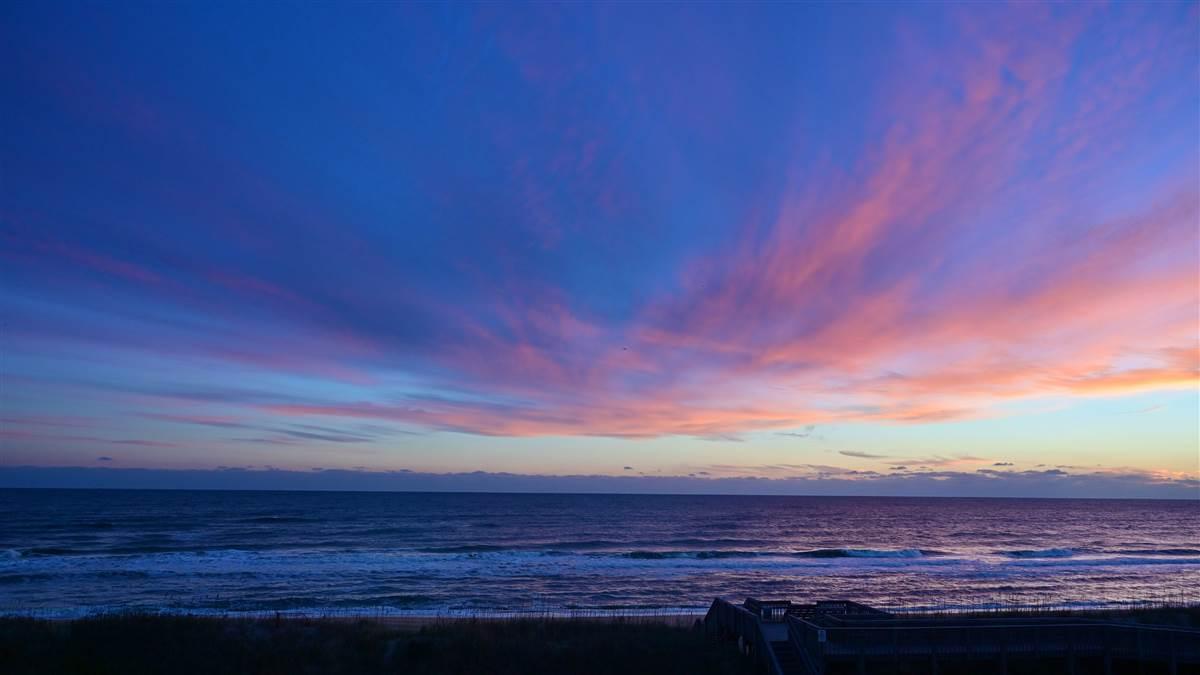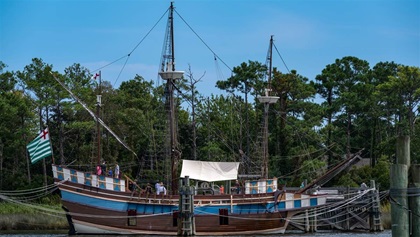Dare County, North Carolina
Outer Banks beaches and lost colonies

The modest First Flight Airport (FFA)—with one 3,000-foot by 60-foot runway—lies at the base of Kill Devil Hill, a tall sand dune on which the Wright Brothers National Memorial was erected in 1932. It’s a significant American historical site, especially meaningful for pilots, but the airport lacks any amenities for aircraft, such as fuel or hangars. You can only tie down for a maximum of 24 hours, and only twice a month. Food, lodging, and beaches are within walking or biking distance, but unless you’re only staying for the day, a better base for your aircraft may be on nearby Roanoke Island. So, after visiting the Wright brothers’ sites at Kill Devil Hills, fly over to Dare County Regional Airport, seven miles southwest across Albemarle Sound, to fuel up, tie down, and explore the mystery of the “Lost Colony.”
Dare County Regional Airport
For aircraft that require longer runways and fuel, or if the sea breeze is too brisk and you need a choice of runways, Dare County Regional Airport (MQI) is the place to land on the Outer Banks. It has two intersecting runways, 5/23 and 17/35, with the longest being 4,300 feet long. The airport can provide 100LL and Jet A fuel, oxygen, aircraft repairs, hangars, and tiedown space. The staff can also arrange for a rental car to be delivered or call a taxi.
Check notams before arriving at Dare County, as this can be a lively airport. With so many tourists making the Outer Banks a vacation destination, the airport often needs a temporary control tower during peak months. It’s also a feeder airport for FedEx and UPS, and a base for banner towing, skydiving, and scenic flights, so keep your eyes open and check for ATC tower operations.
A civil airport was under construction at this site in 1941 when the Japanese attacked Pearl Harbor. It was quickly completed and commandeered by the Navy to train pilots for carrier-based aircraft such as F4F Wildcats, F6F Hellcats, and F4U Corsairs. The U.S. Navy and Coast Guard flew anti-submarine patrols from the airport until the end of the war when it was returned to Dare County.
The airport is located on Roanoke Island in Albemarle Sound and sheltered from the ocean by barrier islands, so there’s less salty spray blowing here. It’s a quick drive over a bridge and causeway to the Outer Banks beaches, hotels, and restaurants. A couple of the best-reviewed restaurants in the area are along this road, overlooking Albemarle Sound.
Inside the terminal building is a small museum on the history of Outer Banks aviation, Dare County Regional Airport Museum. Exhibits feature uniforms, photographs, documents, and artifacts from the World War II Navy squadrons that trained here and the Civil Air Patrol coastal patrol. One room focuses on local aviator, Dave Driskill, who was a barnstormer, National Park Service pilot, a Kellett Autogiro test pilot, the first airport manager of Dare County Regional Airport, and the person usually credited with bringing aviation to the Outer Banks in the 1930s.
 You can jump out of a perfectly good airplane with a tandem skydive at Skydive OBX, or cruise over the beach in a vintage Waco biplane with Barrier Island Aviation, both based at Dare County. Jumpers Away is a flight school for jump pilots.
You can jump out of a perfectly good airplane with a tandem skydive at Skydive OBX, or cruise over the beach in a vintage Waco biplane with Barrier Island Aviation, both based at Dare County. Jumpers Away is a flight school for jump pilots.
Visit the local underwater wildlife at the North Carolina Aquarium on Roanoke Island, immediately adjacent to the airport. It offers numerous programs for children and adults, including a wetlands nature walk, paddling trips around the island, classes to learn the basics of fishing and crabbing, or a chance to swim with sharks.
The Fort Raleigh National Historic Site preserves the site of the first English colony in North America, established by Sir Walter Raleigh in 1585. The colony was the birthplace of Virginia Dare, the first English child born in the New World, and became famous as the “Lost Colony of Roanoke” when the settlers disappeared in 1590. Not much remains, just a grassy mound that marks the site of the colony’s fort.
“The Lost Colony” is a historical drama based on Sir Walter Raleigh’s settlement on Roanoke Island and the disappearance of the colonists, leaving behind only the word “Croatoan” carved on a post. On the 350th anniversary of the settlers’ arrival, in 1937, Roanoke Islanders built the outdoor Waterside Theatre near the spot where the colonists landed and the play has run every year since, except for a break during World War II. It’s a classic American family event, like visiting Williamsburg, Virginia.
The major town on the island is Manteo, two miles east of the airport. Head here for a selection of restaurants and to visit the Roanoke Island Festival Park. The park is a historical recreation of the “Lost Colony” settlement with costumed interpreters demonstrating how the settlers lived and worked. Children will love exploring the park’s American Indian Town, Settlement Site, and Adventure Museum while learning early American history. The highlight may be the Elizabeth II, a replica of a sixteenth century merchant sailing ship like the ones used by the settlers. Onboard interpreters, dressed as sailors and colonists who sailed in Raleigh’s fleet, demonstrate the workings of the ship and what life was like onboard.
The park is also a venue for concerts and outdoor theater and includes nature trails for walking. From Manteo, head east across the bridge to the Outer Bank beaches.


